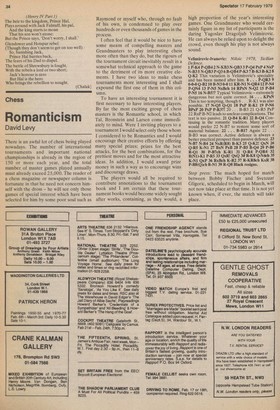Chess
Romanticism
David Levy
There is an awful lot of chess being played nowadays. The number of international tournaments and important national championships is already in the region of 150 or more each year, and the total number of master games played annually must already exceed 25,000. The reader of a chess magazine or newspaper column is fortunate in that he need not concern himself with the dross — he will see only those games of special interest which have been selected for him by some poor soul such as Raymond or myself who, through no fault of his own, is condemned to play over hundreds or even thousands of games in the process.
I often feel that it would be nice to have some means of compelling masters and Grandmasters to play interesting chess more often than they do, but the rigours of the tournament circuit inevitably result in a somewhat technical approach to the game to the detriment of its more creative elements. I have two ideas to make chess tournaments more interesting and I shall expound the first one of them in this column.
To have an interesting tournament it is first necessary to have interesting players. By far the most exciting group of chess masters is the Romantic school, in which Tal, Bronstein and Larsen come immediately to mind. Were I inviting players to a tournament I would select only those whom I considered to be Romantics and I would encourage their creative efforts by offering many special prizes: prizes for the best attacks, for the best combinations, for the prettiest moves and for the most attractive ideas. In addition, I would award prize money in such a way as to encourage wins and discourage draws.
The players would all be required to contribute annotations to the tournament book and I am certain that these tournament books would become widely sought after works, containing, as they would, a high proportion of the year's interesting games. One Grandmaster who would certainly figure in my list of participants is the daring Yugoslav Dragoljub Velimirovic. He can always be relied upon to delight the crowd, even though his play is not always sound.
Velimirovic-Ivanovic: Niksic 1978, Sicilian Defence.
1 P-K4 P-QB4 2 N-K83 N-QB3 3 P-Q4 PxP 4 NxP N-B3 5 N-QB3 P-Q3 6 B-QB4 P-K3 7 B-K3 B-K2 8 Q-K2 This variation is Velimirovic's speciality and has been named after him. 8. . . P-QR3 9 0-0-0 Q-B2 10 B-N3 0-0 11 KR-N1 N-QR4 12 P-N4 P-QN4 13 P-N5 NxBch 14 RNN N-Q2 15 P-B4 P-N5 16 N-B5!? Typical Velimirovic extremely dangerous but not quite correct. 16 . . . KINN This is too tempting, though 6 . . . R-K1 was also possible. 17 N-Q5 Q-Q1 18 PxP R-K1 19 P-N6 BPxP 20 PxP P-R3?! 20 . . . B-B3 21 Q-R5 PxP 22 RxP B-N2 leads to unclear complications. The text is too passive. 21 Q-B4 K-Rl 22 B-Q4 Continuing in the romantic tradition. Many players would prefer 22 N-B7 to restore some sort of material balance. 22 . . . B-B1? Again 22 . . . B-B3 was correct. Active defence is always a better practical prospect than passive defence. 23 N-B7 N-B4 24 NxR(R8) B-K3 25 Q-K2! QxN 26 Q-R5 K-N1 27 BxN PxB 28 P-B5 B-Q4 29 P-B6 R-Ql 30 P-B7ch K-Rl 31 Q-R4 P-QR4 32 R(N1)-K1 P-R5 33 QxR! QxQ 34' R-K8 Q-N4ch 35 K-Ni QxP 36 RxBch K-R2 37 R-KR8ch KxR 38 P-B8(Q)ch B-NI 39 R-Q8 Black resigns.
Stop press: The much hoped for match between Bobby Fischer and Svetozar Gligoric, scheduled to begin in March, will not now take place at that time. It is not yet known when, if ever, the match will take place.





 Previous page
Previous page